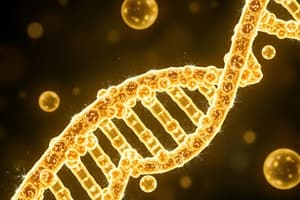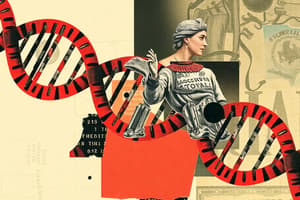Podcast
Questions and Answers
What is the rate of elongation in bacteria?
What is the rate of elongation in bacteria?
- 100 nucleotides per second
- 500 nucleotides per second (correct)
- 50 nucleotides per second
- 5 nucleotides per second
How many RNA primers are required for the leading strand?
How many RNA primers are required for the leading strand?
- None
- Multiple
- One (correct)
- Two
Which enzyme is responsible for joining RNA nucleotides into a primer?
Which enzyme is responsible for joining RNA nucleotides into a primer?
- DNA polymerase I
- DNA ligase
- Primase (correct)
- DNA polymerase III
What does DNA polymerase III do after reaching the next RNA primer to the right?
What does DNA polymerase III do after reaching the next RNA primer to the right?
Which DNA polymerase replaces RNA nucleotides with DNA nucleotides in adjacent primers?
Which DNA polymerase replaces RNA nucleotides with DNA nucleotides in adjacent primers?
What enzyme joins the sugar-phosphate backbones of Okazaki fragments into a continuous DNA strand?
What enzyme joins the sugar-phosphate backbones of Okazaki fragments into a continuous DNA strand?
Which enzyme cannot join the final nucleotide of a replacement DNA segment to the adjacent Okazaki fragment?
Which enzyme cannot join the final nucleotide of a replacement DNA segment to the adjacent Okazaki fragment?
What is the role of DNA pol III in bacterial DNA replication?
What is the role of DNA pol III in bacterial DNA replication?
What happens when DNA pol I adds DNA nucleotides to the 3' end of fragment 1?
What happens when DNA pol I adds DNA nucleotides to the 3' end of fragment 1?
What is the function of DNA ligase in DNA replication?
What is the function of DNA ligase in DNA replication?
How are Okazaki fragments synthesized during DNA replication?
How are Okazaki fragments synthesized during DNA replication?
What is the main role of DNA polymerase I in DNA replication?
What is the main role of DNA polymerase I in DNA replication?
Which enzyme is responsible for unwinding the double helix during DNA replication?
Which enzyme is responsible for unwinding the double helix during DNA replication?
In which direction does DNA synthesis proceed during replication?
In which direction does DNA synthesis proceed during replication?
What happens at the end of each cycle of DNA replication?
What happens at the end of each cycle of DNA replication?
Which enzyme is NOT involved in the process of joining Okazaki fragments?
Which enzyme is NOT involved in the process of joining Okazaki fragments?
What is the role of topoisomerases during DNA replication?
What is the role of topoisomerases during DNA replication?
How many origins of replication may a eukaryotic chromosome have?
How many origins of replication may a eukaryotic chromosome have?
What is the purpose of synthesizing short RNA primers on the lagging strand during DNA replication?
What is the purpose of synthesizing short RNA primers on the lagging strand during DNA replication?
Flashcards are hidden until you start studying
Study Notes
- Helicase unwinds the parental double helix during DNA replication.
- Single strand binding proteins stabilize the unwound template strands to assist in replication.
- Leading strand synthesis occurs continuously in the 5′ to 3′ direction by DNA Polymerase III (Pol III).
- Primase initiates RNA primer synthesis for the Okazaki fragments in the lagging strand.
- DNA Pol III completes synthesis of a fragment before detaching to add DNA nucleotides to the next fragment.
- DNA Pol I removes RNA primers and replaces them with DNA nucleotides, leaving a free 3’ end.
- DNA ligase joins Okazaki fragments together to form a continuous DNA strand.
- Cells are exposed to DNA-damaging agents, which can lead to mutations if not repaired.
- DNA repair mechanisms include proofreading by DNA polymerases, mismatch repair, and nucleotide excision repair.
- Semiconservative DNA replication was demonstrated by Meselson and Stahl.
- Bacterial DNA replication involves several proteins like helicase, single-strand binding proteins, and topoisomerase.
- Replication forks are where new DNA strands elongate during replication.
- DNA polymerases require primers for nucleotide addition, with a rate of about 500 nucleotides per second in bacteria.
- Leading and lagging strands are synthesized differently, with the lagging strand requiring multiple primers.
- Eukaryotic chromosomes have multiple origins of replication and replicate bidirectionally.
- DNA synthesis always proceeds in the 5′ to 3′ direction.
- Telomeres are snipped off at the end of each replication cycle, leading to shorter DNA strands.
- DNA polymerases proofread newly synthesized DNA to correct any errors.
Studying That Suits You
Use AI to generate personalized quizzes and flashcards to suit your learning preferences.




